|
Sentencing Trends |
||
|
|
An Analysis of New South Wales Sentencing Statistics |
|
|
Published by the Judicial Commission of New South Wales |
||
|
Editor – Ivan Potas – Research Director |
||
|
Number 18 – August 1998 |
||
Common Offences in the Higher Courts 1990 – 1997
Introduction
This issue of Sentencing Trends analyses the twenty most common offences dealt with in the District and Supreme Courts (higher courts) from 1990 – 1997. These offences provide an overview of the types of offences dealt with and seek to offer an insight into general sentencing practice. Sentencing statistics from the 1990 – 1993 period were compared to figures from the 1994 – 1997 period to ascertain whether the type and prevalence of offences and penalties imposed have changed over time. Statistics from this paper can be compared to the findings from a previous study published in 1994 as Sentencing Trends No 6, “Common Offences in the Higher Courts”.
About the Data
The data are based on first instance decisions finalised in the District and Supreme Courts between 1 January 1990 and 31 December 1997, which have been amended with outcomes from decisions of the Court of Criminal Appeal.
The statistics are based on the “principal offence”, that is, the offence that attracts the most serious penalty in the group of offences for which an offender has been sentenced. The data do not include cumulative penalties.1
In this paper, the term “average” denotes the median or mid-point of a range of penalties.
Overview
Figure 1 shows the frequency of all principal offences dealt with in the higher courts from 1990 – 1997. As can be seen, there has been a steady decline in the number of cases dealt with since 1992.
Figure 1
Frequency of principal offence cases dealt with in the higher courts 1990-1997
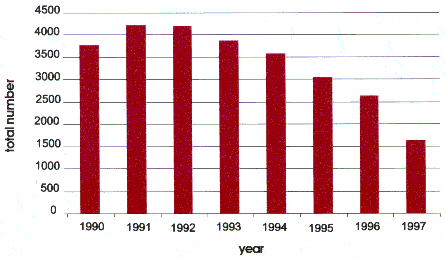
This data should be viewed in the context of legal and administrative reform. In the early 1990s, the courts attempted to reduce the backlog of cases awaiting trial. Various strategies were adopted to increase the disposal rate of cases such as the appointment of acting judges.2
In September 19953 , changes introduced into the Criminal Procedure Act 1986 (NSW) enabled many more indictable matters to be heard summarily than was the case previously. This enabled magistrates to hear more serious matters and resulted in a filtering out of shorter matters to the Local Court. The District Court of New South Wales Annual Review 1996, also reported a trend for matters previously dealt with in the Supreme Court to be commenced in the District Court, and a continuing increase in the number of long trials heard in the District Court.4
These changes, together with the fact that there has been an increase in the number of trials which have resulted in the discharge of the jury or the inability of the jury to reach unanimous agreement, help explain the decrease in the number of matters heard.5
The twenty most common offences
The twenty most common offences make up 57.2% of all offences dealt with in the higher courts. The offences fall into the following categories –
- drug offences including supply prohibited drug, cultivate prohibited plant, import prohibited drug and knowingly take part in supply of a prohibited drug (28%);
- theft cases, including break enter and steal, take conveyance without consent, receiving and larceny (27%);
- assaults, including indecent assault, malicious wounding, maliciously inflict grievous bodily harm, assault occasioning actual bodily harm and common assault (20%);
- robbery offences, including armed robbery, (15%); and
- fraud, escape and culpable driving offences (the remaining 10%).
The most common offences in this data are not necessarily the most serious. For example, the offence of murder, dealt with exclusively by the Supreme Court, is a comparatively rare offence. In fact, nearly all of the cases in the top twenty list are derived from matters heard at first instance in the District Court.
The vast majority of the most common offences in the higher courts were prosecuted under just two New South Wales Acts. The Crimes Act 1900 (NSW) accounted for nearly three quarters (73.1%) of all these offences and a further 17.4% of offences were prosecuted under the Drug Misuse and Trafficking Act 1985 (NSW).
Comparison of Offences – 1990 – 1993 and 1994 – 1997
Note All section numbers refer to the Crimes Act 1900 (NSW) unless otherwise stated.
The top twenty offences for the 1990 – 1993 period (the “earlier period”) were compared with the top twenty offences for the 1994 – 1997 period (the “later period”). The twenty most common offences from the earlier period represent more than half (56.2%) of the total number of cases across the two periods, reflecting the gradual and steady decline in the number of matters heard since 1992.
It is interesting to note that for the earlier period, the twenty most common offences comprised 64% of the total number of cases for that period, whilst for the later period this proportion had dropped to 57.9%. The introduction of new offences in the later period may account for the increase in diversity of the common offences.
More detailed analysis of the two periods show that four of the top five offences were the same in both periods. These were –
- supply drugs, s 25 Drug Misuse and Trafficking Act 1985 (NSW)
- cultivate prohibited plant, s 23 Drug Misuse and Trafficking Act 1985 (NSW)
- break enter and steal, s 112 (old)6
- armed robbery, s 97 (old)
The later period also included the most recent provisions dealing with armed robbery (s 97 (1)) as the third most common offence, while the earlier period included assault occasioning actual bodily harm (s 59) as the fourth most common offence (which was sixth most common in the later period).
Table 1 shows that most of the offences which appeared in the earlier period but did not appear in the later period were absent because they had been repealed for most, if not all, of the later period. Repealed offences included culpable driving (s 52A (1)(f)), indecent assaults (s 61E (1) and s 61E (1A)) and sexual intercourse without consent (s 61D (1)). There was one exception, escape lawful custody (s 34 Correctional Centres Act 1952 (NSW), formerly the Prisons Act (NSW)), which was the tenth most frequent offence in the earlier period, but was no longer included in the twenty most common offences in the later period.
Table 1
Comparison of Offences – 1990-1993 and 1994-1997
|
rank |
frequency |
percentage |
frequency |
percentage |
||||
|
1990-1993 |
1994-1997 |
act | section | offence7 |
1990-1993 |
1990-1993 |
1994-1997 |
1994-1997 |
|
2 |
1 |
Drug Misuse & Trafficking Act 1985 | 25 | supply prohibited drug |
1544 |
9.6 |
1306 |
12.01 |
|
1 |
2 |
Crimes Act 1900 | 112 (old) | break, enter steal |
1635 |
10.17 |
492 |
4.53 |
|
3 |
5 |
Crimes Act 1900 | 97 (old) | armed robbery |
891 |
5.54 |
408 |
3.75 |
|
4 |
6 |
Crimes Act 1900 | 59 | assault occasioning actual bodily harm |
868 |
5.4 |
408 |
3.75 |
|
5 |
4 |
Drug Misuse &Trafficking Act 1985 | 23 (1) (a) | cultivate prohibited plant |
717 |
4.46 |
446 |
4.10 |
|
6 |
13 |
Crimes Act 1900 | 61 | common assault |
630 |
3.92 |
172 |
1.58 |
|
8 |
8 |
Crimes Act 1900 | 188 | receiving |
413 |
2.57 |
235 |
2.16 |
|
7 |
16 |
Crimes Act 1900 | 154A & 154AA | take conveyance without consent |
453 |
2.82 |
153 |
1.41 |
|
9 |
9 |
Crimes Act 1900 | 94 | robbery |
303 |
1.88 |
201 |
1.85 |
|
– |
3 |
Crimes Act 1900 | 97 (1) | armed robbery |
0 |
0.0 |
477 |
4.39 |
|
11 |
14 |
Crimes Act 1900 | 117 | larceny |
274 |
1.7 |
169 |
1.55 |
|
16 |
10 |
Crimes Act 1900 | 35 (a) | malicious wounding |
204 |
1.27 |
199 |
1.83 |
|
10 |
– |
Correctional Centres Act 1952 | 34 | escape |
281 |
1.75 |
114 |
|
|
– |
7 |
Crimes Act 1900 | 112 (1) | break, enter steal |
0 |
0.0 |
394 |
3.62 |
|
17 |
11 |
Crimes Act 1914 (Cth) | 29B | false representation |
204 |
1.27 |
186 |
1.71 |
|
14 |
17 |
Crimes Act 1900 | 178BA | obtain money by deception |
238 |
1.84 |
149 |
1.37 |
|
13 |
– |
Crimes Act 1900 | 52A (1)(f) repealed | culpable driving causing death – speed/drive in manner dangerous |
253 |
1.57 |
– |
– |
|
12 |
– |
Crimes Act 1900 | 61E (1A) repealed | indecent assault <16 and under authority |
263 |
1.64 |
– |
– |
|
15 |
– |
Crimes Act 1900 | 61E (1) repealed | indecent assault |
227 |
1.41 |
– |
– |
|
15 |
Drug Misuse & Trafficking Act 1985 | 25 | knowingly take part in supply prohibited drug |
142 |
155 |
1.43 |
||
|
19 |
19 |
Customs Act 1901 (Cth) | 233B | import prohibited import – trafficable quantity |
166 |
1.03 |
127 |
1.17 |
|
– |
12 |
Crimes Act 1900 | 35 (b) | maliciously inflict grevous bodily harm |
106 |
173 |
1.59 |
|
|
19 |
19 |
Customs Act 1901 (Cth) | 233B | import prohibited import – trafficable quantity |
166 |
1.03 |
127 |
1.17 |
|
– |
12 |
Crimes Act 1900 | 35 (b) | maliciously inflict grevous bodily harm |
106 |
– |
173 |
1.59 |
|
– |
20 |
Crimes Act 1900 | 99 | demand money with intent to steal |
129 |
121 |
1.11 |
|
|
20 |
– |
Crimes Act 1900 | 52A (1)(f) repealed | culpable driving causing grevous bodily harm – speed/drive in manner dangerous |
158 |
0.98 |
– |
– |
|
18 |
Crimes Act 1900 | 61D (1) repealed | sexual intercourse without consent |
174 |
1.08 |
– |
– |
|
|
18 |
Crimes Act 1900 | 61M (1) | aggravated indecent assault |
59 |
137 |
1.26 |
||
| total in top 20 |
9,896 |
61.54% |
6,108 |
56.18% |
||||
| total overall |
16,079 |
10,872 |
||||||
Two other offences also dropped markedly in their ranking from the earlier period to the later period. Common assault (s 61) dropped from sixth most common offence in the earlier period to thirteenth most common in the later period. Similarly, take conveyance without consent (s 154A) dropped from seventh most common offence in the earlier period to sixteenth most common in the later period.
(See Table 1 Comparison of Offences – 1990-1993 and 1994-1997).
Conversely, cases that were in the top twenty in the later period but not in the earlier period were mostly new offence provisions, including armed robbery (s 97 (1)) and break enter steal: s 112 (1).
There were four offences which appeared in the top twenty offences of the later period but not in the earlier period which were not new offences. They were maliciously inflict grievous bodily harm (s 35 (b)); knowingly take part in supply of prohibited drug (s 25 Drug Misuse and Trafficking Act 1985 (NSW); demand money with intent to steal (s 99); and aggravated indecent assault: s 61M (1).
Sentencing patterns in the higher courts
Distribution of penalties – 1990 – 1993 and 1994 – 1997
Figure 2 shows the distribution of penalties for the earlier period compared with the later period. It can be seen that the proportion of offenders who received a sentence of imprisonment or periodic detention has increased in the later period, with a corresponding decrease in the proportion of offenders who were given non-custodial options such as community service orders, bonds and fines. This finding is consistent with the previous observation that District Court matters during the later period deal with more serious cases than in the past.
Figure 2
Distribution of penalties – 1990-1993 and 1994-1997
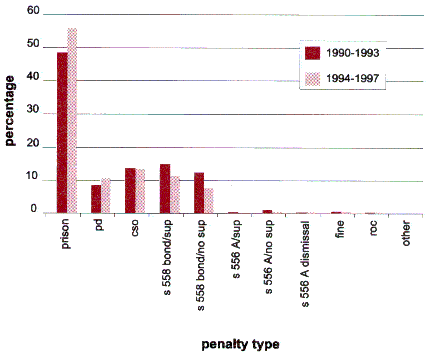
Analysis of the average penalty length for the custodial options between the two periods shows that although the average minimum terms (18 months) have remained the same, the averages for full terms of imprisonment and periodic detention have increased slightly. The average full term has increased from 30 months to 36 months and the average term for periodic detention has increased from 15 months to 18 months. Thus, on average, offenders in the later period are more likely to receive imprisonment and longer additional terms and periodic detention orders than those in the earlier period.
Analysis of Offences – 1994 – 1997
Drug offences
Supply prohibited drug, s 25 Drug Misuse and Trafficking Act 1985 (NSW), has become the most common offence dealt with in the higher courts (it was the second most common offence in the earlier period). The type of drug supplied in these cases was mainly heroin (30.67%), amphetamines (27.86%) and cannabis leaf (24.14%).
As Figure 3 shows, the most common disposition for supply prohibited drug was imprisonment, representing more than half of all sanctions during both periods. There is little difference in the sentencing patterns for the two periods, except for a slight increase in the use of periodic detention and community service orders during the later period offset by a decreased use of imprisonment and s 558 bonds, with and without supervision. As would be expected, fines and s 556A bonds are rarely imposed for this offence.
Figure 3
Supply prohibited drug
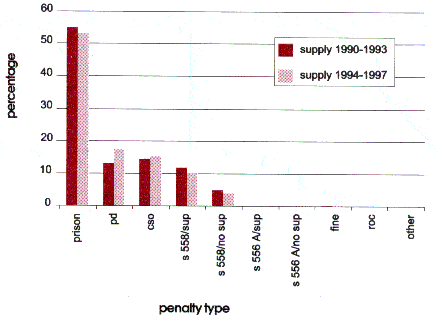
Table 2
Median terms for supply prohibited drug
| 1990-1993 | 1994-1997 | |
| full terms minimum terms periodic detention community service order |
30 months 18 months 18 months 300 hours |
30 months 15 months 18 months 300 hours |
Across the two periods there was no change in the length of full terms, periodic detention orders or community service orders. There was, however, a reduction in the length of minimum terms in the later period. Not surprisingly, nearly all offences of cultivate prohibited plant (s 23 Drug Misuse and Trafficking Act 1985 (NSW)), concerned cannabis plant (99.23%). There was a different pattern of sentencing for this offence, which has moved from being the fifth most common offence in the earlier period to fourth most common offence in the later period.
Table 3
Median terms for cultivate prohibited plant
| 1990-1993 | 1994-1997 | |
| full terms minimum terms periodic detention |
20 months 12 months 15 months |
24 month 11 months 13.5 months |
Across the two periods there were decreases in the length of minimum terms and periodic detention orders. There was, however, an increase in the length of full terms in the later period.
The offence of import prohibited drug, (s 233B Customs Act 1901 (Cth)), was the nineteenth most common offence in both periods. Most of the cases of importation concerned either heroin (59.04%) or cocaine (32.76%).
Table 4
Median terms for import prohibited drug
| 1990-1993 | 1994-1997 | |
| full terms non-parole period periodic detention |
72 months 48 months 21 months |
72 months 48 months 18 months |
The offence of knowingly take part in supply prohibited drug, (s 25 Drug Misuse and Trafficking Act 1985 (NSW), is the fifteenth most common offence in the later period but did not appear in the earlier period.
Break, enter and steal
The second most common offence was break, enter and steal (s 112) relating to the older provisions (in the earlier period it was the most common offence). The drop in the ranking is obviously partly caused by the statistics being split between these repealed provisions and later amendments dealing with this type of offence.8 The newer provisions (s 112 (1)) were ranked seventh in the list of the top twenty offences and because of their commencement date did not, of course, appear in the earlier period.
Figure 4
Break, enter and steal
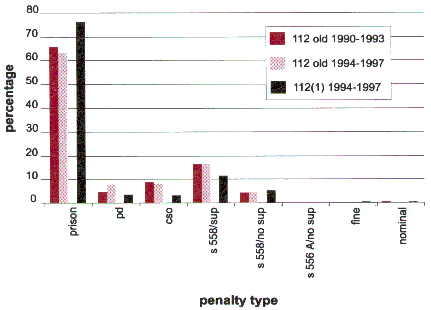
The offences of break, enter and steal are illustrated in Figure 4. A comparison between periods for the older provisions alone indicates that a slightly smaller proportion of offenders received imprisonment in the later period and that there was more extensive use of periodic detention orders with the length of orders, full terms of imprisonment, and community service orders increasing.
Table 5
Median terms for break, enter and steal
| s 112 old 1990-1993 |
s 112 old 1994-1997 |
s 112 (1) 1994-1997 |
|
| full terms minimum terms periodic detention community service order |
30 months 18 months 15 months 250 hours |
32 months 14 months 16.5 months 300 hours |
36 months 18 months 12 months 370 hours |
These older provisions can be contrasted with the new s 112 (1), where a far greater proportion of offenders were sentenced to imprisonment (76.14% compared to 65.79% and 63.21% in the early and later periods respectively). In addition, the average imprisonment terms for this offence increased despite no increase in the maximum penalty for this offence.
Armed robbery
The third most common offence was armed robbery: s 97 (1). The older section dealing with armed robbery (s 97) was still ranked fifth in the list of the top twenty offences (in the earlier period it was third most prevalent), the drop in the ranking obviously caused by the statistics being split between the old and the new provisions dealing with this offence.
The three offences are illustrated in Figure 5. A comparison between periods for the repealed provisions alone indicates a more extensive use of imprisonment and periodic detention during the later period for this offence, although the length of minimum terms has decreased. Similar but smaller decreases were evidenced in the length of full terms of imprisonment and periodic detention orders.
Figure 5
Armed Robbery
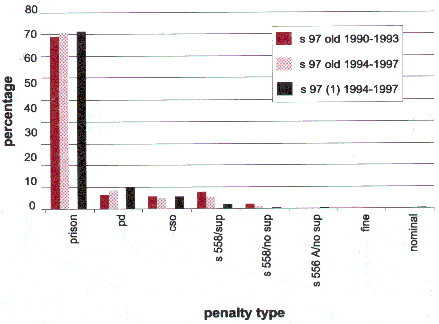
The newer offence of s 97 (1) has the same average imprisonment terms as the old s 97. In the later period, however, a slightly greater percentage of offenders received custodial penalties and community service orders, and less bonds overall were imposed.
Table 6
Median terms for armed robbery
| s 97 old 1990-1993 |
s 97 old 1994-1997 |
s 97 (1) 1994-1997 |
|
| full terms minimum terms periodic detention community service order |
50 months 33 months 34 months 300 hours |
48 months 24 months 21 months 300 hours |
48 months 24 months 18 months 400 hours |
Assaults
The sixth most common offence was assault occasioning actual bodily harm (s 59), it was ranked fourth in the earlier period. Figure 6 shows that there has been an increased reliance on imprisonment, periodic detention and supervised bonds (s 558 recognizance with supervision) for this offence in the later period.
Figure 6
Assault occasioning actual body harm
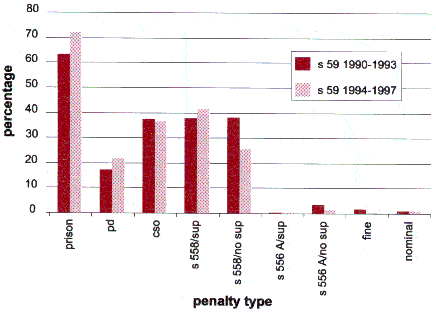
There has been no change in the length of minimum terms or periodic detention orders for this offence, but a slight increase in the length of full terms occurred in the later period.
Table 7
Median terms for assault occasioning actual bodily harm
| 1990-1993 | 1994-1997 | |
| full terms minimum terms periodic detention |
16 months 9 months 12 months |
18 months 9 months 12 months |
Malicious wounding (s 35 (a)) was the tenth most common offence in the later period and the sixteenth most common offence in the earlier period. During the earlier period a little less than half of all offenders (49%) were sentenced to imprisonment for this offence. This proportion has, however, risen sharply to 60.8% of offenders during the later period. Although more people are being imprisoned during the later period, the length of minimum terms has decreased slightly but the length of full terms has increased.
Table 8
Median terms for malicious wounding
| 1990-1993 | 1994-1997 | |
| full terms minimum terms periodic detention |
30 months 18 months 15 months |
32 months 15 months 15 months |
Maliciously inflict grievous bodily harm (s 35 (b)), was the twelfth most common offence but did not appear in the top twenty offences in the earlier period. The sentencing pattern is quite similar to that for s 35 (a) with an increased reliance on custodial penalties.
Table 9
Median terms for maliciously inflict grievous bodily harm
| 1990-1993 | 1994-1997 | |
| full terms minimum terms periodic detention |
– – – |
33 months 18 months 13.5 months |
Common assault (s 61) was the thirteenth most common offence in the later period. In the earlier periodit was the sixth most common offence. There is little change in the sentencing patterns across the two periods with no change in the length of periodic detention orders or the length of minimum terms but a slight increase in the length of full terms.
Table 10
Median terms for common assault
| 1990-1993 | 1994-1997 | |
| full terms minimum terms periodic detention |
6 months 6 months 9 months |
7.5 months 6 months 9 months |
Larceny offences
Larceny offences which appeared in the top twenty offences included take conveyance without consent (s 154A), simple larceny (s 117), and receiving (s 188). Receiving ranked eighth most frequent and held the same position in the earlier period. On the other hand, take conveyance without consent dropped sharply from sixth most frequent offence to thirteenth most frequent in the later period. Simple larceny had a less severe decline from eleventh to fourteenth most common offence in the later period.
The most frequently imposed sanction for this group of offences was imprisonment. The sentencing pattern for receiving has changed across the periods and Figure 7 shows that there has been an increased reliance on imprisonment and community service orders for this offence in the later period. The length of full terms has also increased but the length of minimum terms has remained the same across the two periods.
Figure 7
Receiving

Table 11
Median terms for receiving
| 1990-1993 | 1994-1997 | |
| full terms minimum terms periodic detention |
16 months 12 months 15 months |
21 months 12 months 13.5 months |
The sentencing patterns for take conveyance without consent show an increase in the length of full terms and periodic detention terms. The sentencing patterns for larceny show an increase in full terms and a decrease in minimum terms across the two periods.
Table 12
Median terms for larceny and take conveyance without consent
| Larceny | ||
| 1990-1993 | 1994-1997 | |
| full terms minimum terms periodic detention |
16 months 12 months 18 months |
18 months 9 months 18 months |
| Take conveyance without consent | ||
| 1990-1993 | 1994-1997 | |
| full terms minimum terms periodic detention |
16 months 12 months 12 months |
21 months 12 months 15 months |
Robbery
The ninth most common offence was robbery (s 94), the same position it held in the earlier period. Figure 8 shows a large increase in the use of imprisonment (54.5% to 71.6%) and a large decrease in the use of s 558 supervised bonds (25.1% to 7.5%) across the two periods.
Figure 8
Robbery

There were decreases in the length of periodic detention orders, minimum terms and community service orders. The length of the full terms has, however, increased from an average of 30 months to a average of 36 months across the two periods.
Table 13
Median terms for robbery
| 1990-1993 | 1994-1997 | |
| full terms minimum terms periodic detention community service order |
30 months 18 months 21 months 350 |
36 months 15 months 18 months 300 |
Fraud offences
The frequency of false representation (s 29B Crimes Act 1914 (Cth)) offences has increased. Formerly ranked seventeenth most frequent, it is now ranked eleventh. Interestingly, the frequency of obtain money by deception (s 178BA) offences has decreased. Formerly ranked twelvth most frequent, it is now ranked seventeenth.
False representation offences, unlike other common offences, most often attract non-custodial sentences. Almost 40% of offenders received a community service order with an average length of 300 hours. Conversely, prison was the most common penalty for obtain money by deception offences. The use of this sanction increased from 31.5% of offenders in the earlier period to 46.3% of offenders in the later period.
Table 14
Median terms for false representation and obtain money by deception
| False representation | ||
| 1990-1993 | 1994-1997 | |
| community service order full terms minimum terms periodic detention |
300 hours 12 months 9 months 12 months |
300 hours 12 months 10.5 months 12.5 months |
Obtaining money by deception |
||
| 1990-1993 | 1994-1997 | |
| community service order full terms minimum terms periodic detention |
300 hours 20 months 18 months 12 months |
300 hours 24 months 18 months 12.5 months |
Sexual offences
Three sexual offences (indecent assault, indecent assault on a child less than 16 and under authority, and sexual intercourse without consent) were included in the twenty most frequent offences for the earlier period. They do not appear in the later period because they were repealed in 1991. The newer and more serious offence of aggravated indecent assault (s 61M (1)) does appear in the later period ranked eighteenth most frequent.
The most common disposition imposed for aggravated indecent assault was imprisonment, the average length of full terms of imprisonment was two years four months, with the majority of offenders receiving between 18 months and four years. The average length of periodic detention orders was 18 months and the average length of community service orders was 325 hours.
Conclusion
The most common offences dealt with in the higher courts overall were –
- assaults (18.7%)
- theft (17.8%)
- drugs (17.5%)
- robbery (13.6%)
The type of matters heard since 1990 have remained substantially the same despite some differences in ranking attributable mainly to the jurisdictional changes made in the District and Local Courts.
Overall, the most common penalty disposition imposed was imprisonment. It appears that offenders are now more likely to receive imprisonment as a sentencing option than in the earlier period, and are on average more likely to receive a longer full term sentence. This is true for break enter and steal, assault occasioning actual bodily harm, malicious wounding, maliciously inflicting grievous bodily harm, receiving, robbery, and obtain money by deception offences.
The new provision of break, enter and steal has higher rates of imprisonment than the older provision and longer average full terms. The new provision for armed robbery also has a slightly higher rate of imprisonment than the older provision (though the average full term lengths remain the same) and less use of bonds. Both these offences have been linked to the increase in heroin related crimes which may also account for their growth. Many of these changes also correspond to the jurisdictional amendments that have resulted in District Court matters being concentrated on more serious matters. In turn, this has increased the likelihood of a more severe penalty being imposed.
Endnotes
| * |
Research staff of the Judicial Commission of New South Wales. |
| 1 | Different sentencing considerations apply to cumulative penalties and therefore are not included. |
| 2 | District Court of New South Wales Annual Review at 36. |
| 3 | Part 9A Criminal Procedures Act 1986 (NSW) which commenced 1 September 1995. |
| 4 | District Court of New South Wales Annual Review 1996 at 36. |
| 5 | In the Sydney and Sydney West districts in 1996, nearly one in four trials held were aborted or resulted in a hung jury: District Court of New South Wales Annual Review 1996 at 41. |
| 6 | Both s 112 and s 97 were amended by the Crimes (Home Invasion) Amendment Act 1994 which commenced on 23 December 1994. The amendments inserted the aggravated offences of s 97(2) and s 97 (3) and s 112 (2) and s 112 (3). The simple offences of ss 97 and 112 became ss 97(1) and 112 (1) but remained the same otherwise. However, because the old offences of s 97 and s 112 also carry cases that may now fit into the more aggravated offences, the older cases are distinguished in the data by ss 97 (old) and 112 (old). |
| 7 | The offence description is not necessarily a full description of that section as it appears in the Act. That is, there may be more than one offence per section, but the description identifies which offence is referred to. For example, s 25 of the Drug Misuse and Trafficking Act creates offences for both supply and knowingly supply prohibited drug, both of which appear in this list. |
| 8 | See footnote 5. |
ISSN 1036 4722
Published by the Judicial Commission of New South Wales
| Location: | Level 5, 301 George St, Sydney NSW 2000, Australia |
| Postal address: | GPO Box 3634, Sydney NSW 2001 |
| Telephone: | 02 9299 4421 |
| Fax: | 02 9290 3194 |
| Email: | judcom@judcom.nsw.gov.au |
| Website: | www.judcom.nsw.gov.au |
Disclaimer
This paper was prepared by officers of the Judicial Commission for the information of the Commission and for the information of judicial officers. The views expressed in the report do not necessarily reflect the views of the Judicial Commission itself but only the views of the officers of the Commission who prepared this report for the Commission.












